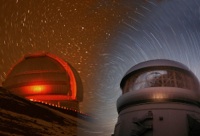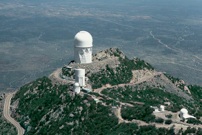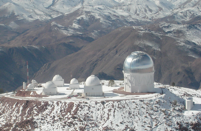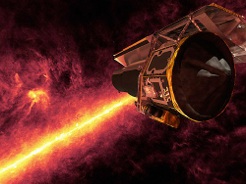Most of my work is on how distant galaxies form and evolve, and how that evolution is related to their larger scale environment. Due to the redshifting of light, studies of distant galaxies almost always involve infrared observations. Below are some of the projects/surveys I’ve been involved with recently.


The UltraVISTA Survey
UltraVISTA is an ESO public survey using VIRCAM on the VISTA 4m telescope to perform very deep imaging of the COSMOS field in five filters (YJHK and NB118). The UltraVISTA DR1 is now available and we have published a public Ks-slected catalog of the field and have used the catalog to measure the stellar mass functions of galaxies up to z = 4. The UltraVISTA data has also revealed the first example of a strongly-lensed massive ultra-compact galaxy at z > 2. This highly-magnified galaxy promises to reveal new information on this enigmatic class of galaxies.
Results
- “The Evolution of the Stellar Mass Functions of Star-forming and Quiescent Galaxies to z = 4 from the COSMOS/UltraVISTA Survey”, Muzzin et al. 2013a, ApJ, 777,18
- “A Public Ks-Selected Catalog in the COSMOS/UltraVISTA Field: Photometry, Photometric Redshifts and Stellar Population Parameters”, Muzzin et al. 2013b, ApJS, 206, 433
- “A Strongly-Lensed Massive Ultra-Compact Quiescent Galaxies at z ~ 2.4 in the COSMOS/UltraVISTA Field”, Muzzin et al. 2012, ApJ, 761, 142
- “The Progenitors of Local Ultra-Massive Galaxies Across Cosmic Time: From Dusty Starbursting to Quiescent Populations”, Marchesini et al. 2014, ApJ, Submitted
- “Observations of Environmental Quenching in Groups in the 11 Gyr Since z = 2.5: Different Quenching for Central and Satellite Galaxies:”, Tal et al. 2014, ApJ, Submitted
The Gemini Cluster Astrophysics Spectroscopic Survey (GCLASS)
The Gemini Cluster Astrophysics Spectroscopic Survey (GCLASS) is a comprehensive multiwavelength survey of 10 massive clusters at z ~ 1.1 selected from the 42 square degree SpARCS IR cluster survey. The backbone of GCLASS project is a 220 hr spectroscopic campaign using the GMOS instruments on Gemini North and South. The goals of GCLASS are to characterize the effects of environment on galaxy evolution in the most massive, large-scale structures at high redshift, and also to determine the relationship between dark and luminous matter in the early universe.
Results
- “The Gemini Cluster Astrophysics Spectroscopic Survey: The Role of Environment and Self-Regulation in Galaxy Evolution at z ~ 1”, Muzzin et al. 2012, ApJ, 746, 188
- “Evidence for Significant Growth in the Stellar Mass of Brightest Cluster Galaxies Over the Past 10 Billion Years”, Lidman et al. 2012, MNRAS, 427, 550
- “A Kinematic Approach to Assessing Environmental Effects: Star-forming Galaxies in a z ~ 0.9 SpARCS Cluster using 24um Observations”, Noble et al. 2013, ApJ, 768, 118
- “The Environmental Dependence of the Stellar Mass Function at z ~ 1: Comparing Cluster and Field between the GCLASS and UltraVISTA Surveys”, van der Burg et al. 2013, A&A, 557, 18
- “The Importance of Major Mergers to the Build Up of Stellar Mass in Brightest Cluster Galaxies at z = 1”, Lidman et al. 2013, MNRAS, 433, 825
- “A Census of Stellar Mass in 10 Massive Halos at z ~ 1 from the GCLASS Survey”, van der Burg et al. 2014, A&A, 561, 79
- “The Phase Space and Stellar Populations of Cluster Galaxies at z ~ 1: Simultaneous Constraints on the Location and Timescale of Satellite Quenching”, Muzzin et al. 2014, ApJ, submitted




The NEWFIRM Medium Band Surveys (NMBSI+II)
The NEWFIRM Medium Band Survey is a 72 night NOAO survey project on the KPNO 4m telescope that uses custom built near-infrared medium bands. The medium bands allow high-precision photometric redshifts and rest-frame colors for distant massive galaxies. In 2012 we completed observations for the NMBS-II, a 6 square degree survey designed to find massive “monster” galaxies at z ~ 2. I am leading the data reduction of the NMBS-II.
Results
- “The NEWFIRM Medium Band Survey: Filter Definitions and First Results”, van Dokkum et al. 2009, PASP, 121, 2
- “The Dead Sequence: A Clear Bi-modality in Galaxy Colors from z = 0 to z = 2.5”, Brammer et al. 2009, ApJL, 706, 173
- “The Growth of Massive Galaxies Since z = 2”, van Dokkum et al. 2010, ApJ, 709 1018
- ‘The Age Spread of Quiescent Galaxies with the NEWFIRM Medium Band Survey: Identification of the Oldest Galaxies out to z ~ 2”, Whitaker et al. 2010, ApJ, 719, 1715
The Spitzer Adaptation of the Red-Sequence Cluster Survey (SpARCS)
SpARCS is one of the largest optical/IR surveys for distant (z > 1) galaxy clusters. We use the well-proven cluster red-sequence method shifted into the IR and have detected clusters to distances as high as z = 1.63.
Results
- “Spectroscopic Confirmation of Two Massive Red-Sequence-Selected Galaxy Clusters at z ~ 1.2 in the SpARCS-North Cluster Survey”, Muzzin et al. 2009, ApJ, 698, 1934
- “Spectroscopic Confirmation of a Massive Red-Sequence-Selected Galaxy Cluster at z = 1.34 in the SpARCS-South Cluster Survey”, Wilson et al. 2009, ApJ, 698, 1943
- “Spectroscopic Confirmation of Three Red-Sequence Selected Clusters at z = 0.87, 1.16, and 1.21 from the SpARCS Survey”, Demarco et al. 2010, ApJ, 711, 1185
- “Lensing Magnifcation: A Novel Method to Weight High-Redshift Clusters and its Appication to SpARCS”, Hildebrandt et al. 2011, ApJL, 733, L30
- “Discovery of a Rich Cluster at z = 1.63 Using the Rest-Frame 1.6um ‘Stellar Bump Sequence’ Method”, Muzzin et al. 2013, ApJ, 767, 39



Spitzer Observations of Massive z ~ 2.3 Galaxies
We have been using a sample of massive galaxies with extensive NIR spectroscopy from GNIRS to assess how well we can measure physical parameters of distant galaxies such as stellar masses and star formation rates using locally-calibrated models.
Results
- “A Near-Infrared Spectroscopic Survey of K-selected Galaxies at z ~ 2.3: Comparison of Stellar Population Synthesis Codes and Constraints from the Rest-frame NIR”, Muzzin et al. 2009, ApJ, 701, 1839
- “How Massive are Massive Compact Galaxies?”, Muzzin et al. 2009, ApJL, 706, L188
- “Well-Sampled FIR Spectral Energy Distributions of z ~ 2 Galaxies: Evidence for Scaled up Cool Galaxies”, Muzzin et al. 2010, ApJ, 725, 742
